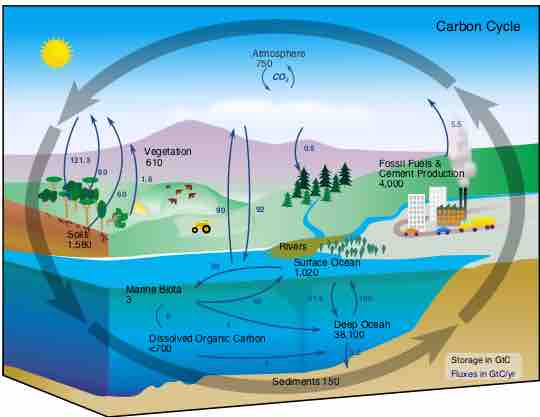Most important substances on Earth, such as oxygen, nitrogen, and water undergo turnover or cycling through both the biotic (living) and abiotic (geological, atmospheric, and hydrologic) compartments of the Earth. Flows of nutrients from living to non-living components of the Earth are called biogeochemical cycles.
Nutrient Cycles and the Biosphere
Ecosystems hinge on biogeochemical cycles. The nitrogen cycle, the phosphorous cycle, the sulfur cycle, and the carbon cycle all involve assimilation of these nutrients into living things. These elements are transferred among living things through food webs, until organisms ultimately die and release them back into the geosphere .

The Carbon Cycle
The element carbon moves from the biosphere to the geosphere and the hydrosphere. This flow from abiotic to biotic compartments of the Earth is typical of biogeochemical cycles.
Reservoirs of Essential Elements
Chemicals are sometimes sequestered for long periods of time and taken out of circulation. Locations where elements are stored for long periods of time are called reservoirs. Coal is a reservoir for carbon, and coal deposits can house carbon for thousands of years. The atmosphere is considered a reservoir for nitrogen.
Humans and Biogeochemical Cycles
Although the Earth receives energy from the Sun, the chemical composition of the planet is more or less fixed. Matter is occasionally added by meteorites, but supplies of essential elements generally do not change. However, human activity can change the proportion of nutrients that are in reservoirs and in circulation. For example, coal is a resevoir of carbon, but the human use of fossil fuels has released carbon into the atmosphere, increasing the amount of carbon in circulation. Likewise, phosphorous and nitrogen are extracted from geological reservoirs and used in phosphorous, and excesses of these elements have caused the overgrowth of plant matter and the disruption of many ecosystems.